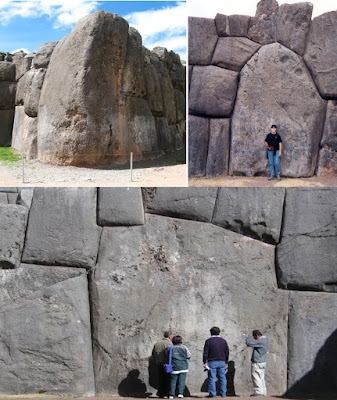Tunnels beneath the Jerusalem Temple
site date back to the construction of the Second Temple in 521 B.C.
Sacsayhuaman is located on the outskirts of the ancient Peruvian capital of Cuzco, resting on an artificially levelled mountaintop, and consists of three outer lines of gargantuan walls, 1,500 feet long and 54 feet wide. They surround a paved area containing a circular stone structure believed to be a solar calendar. The ruins also include a 500,000 gallon water reservoir, storage cisterns, ramps, citadels and underground chambers.
Some
stones at Sacsayhuaman are huge, weighing in excess of 300 to 400 tons. Upper
left stone is 28 feet high
It is also interesting that beneath the city of Jerusalem, in the tunnels dug there in 521 B.C., there is a huge stone block 40 feet long, 12 feet high and 14 feet deep, that has been cut precisely to fit on the stone bases beneath it without mortar, creating the same kind of perfect fit as found in the stones at Sacsayhuaman.
In the tunnel
beneath the Jerusalem temple is large 600-ton stone that is so cut as to not
need mortar and (yellow arrow) fits perfectly on its base stones
Peruvian tunnels beneath the city of
Cuzo and connecting in many cases to Sacsayhuaman
The Sacsayhuaman fortress was a House of the Sun, and those of other nations were not able to enter it because it was a house of the sun. The largest and most magnificent work, the fortress above the city, has a magnitude that is incredible to those who have seen it.
The early Spanish who conquered the region were so taken with the edifice, that they believed its greatness was made by way of enchantment and built by devils and not men, because the multitude of so many stones of such great size, such as those placed on the three terraces, caused vast speculation. The massive stones, many of which weigh many tons, were cut from quarries and moved and fitted so that the joint hardly shows. To think how they could fit stones so immense and so well, where one cannot even insert the blade of a knife in between is remarkable.
Archaeologist claim that this fortress is a “Pre-Inca citadel,” built and belonging to a culture that has yet to be identified. “We calculate that the tunnels would be some 300 feet under Cuzco,” stated Anselm Pi Rambla, “the great question is ascertaining what age it belonged to.” Excavation work aimed at confirming the location of the subterranean galleries confirm the stories of ancient Spanish chroniclers like Garcilaso de la Vega and Cieza de León regarding an underground citadel in Cuzco.
Another area where tunnels have been built under a temple is found at Chavin de Huantar, which is officially dated to approximately 800 B.C., if not earlier. The complex is divided into two clear phases; The 'Old' and the 'New,' with the 'Old' phase dated at around 900 B.C., and the 'New' temples, built over the old are dated at around 500 B.C.
Chavin is a complex of steeply walled platforms, honeycombed with stone-lined passages and surrounding a sunken plaza. It is unique among Pre-Columbian temple groups. The principle edifice, called 'The Castillo' is faced with cut-stone blocks in courses of varying widths. The walls rose 56-feet above a pedestal of cyclopean blocks. Inside the core are at least three irregular stories of stone-lined galleries, chambers and ventilating shafts.
The complex was laid out according to a pre-conceived plan; an area of 300,000 square feet, was flattened and terraced in preparation, and the whole site was aligned to the cardinal points.
A number of engraved obelisks, cyclopean masonry (such as a 30 foot long lintel), and a network of cut-rock tunnels that highlight the unusual quality of the complex. Networks of subterranean tunnels cut from natural rock have been found at the site.
One of the many subterranean tunnels at
Chavin
It should be noted that no such construction achievements have been found in North America, Baja California, the Malay Peninsula, or even in Mesoamerica. One would think that such would have a bearing on those who are seriously looking for an area where they can place the Land of Promise and have it match the descriptions of the Book of Mormon.









Del- I find these two posts absolutely fascinating. Thank you for your ongoing, excellent work.
ReplyDeleteIt just dawned on me that in addition to the temple in Jerusalem and Nephi temple in Cusco, there is a third temple built of stone, surrounded by a stone wall, and with an extensive tunnel system beneath it- Salt Lake City.
ReplyDeleteI believe the foundation was set with quite large stones that were cut so as to not require mortar also.
DeleteThe foundation of Salt Lake is sandstone because sandstone does not deteriorate under ground wereas granite does. You are right little mortar used because of the weight.
DeleteExcellent point. Gave me quite a chuckle.
ReplyDeleteI heard on cosmic disclosure about the tunnels below nazca landscape were they found artifacts very interesting.
ReplyDelete